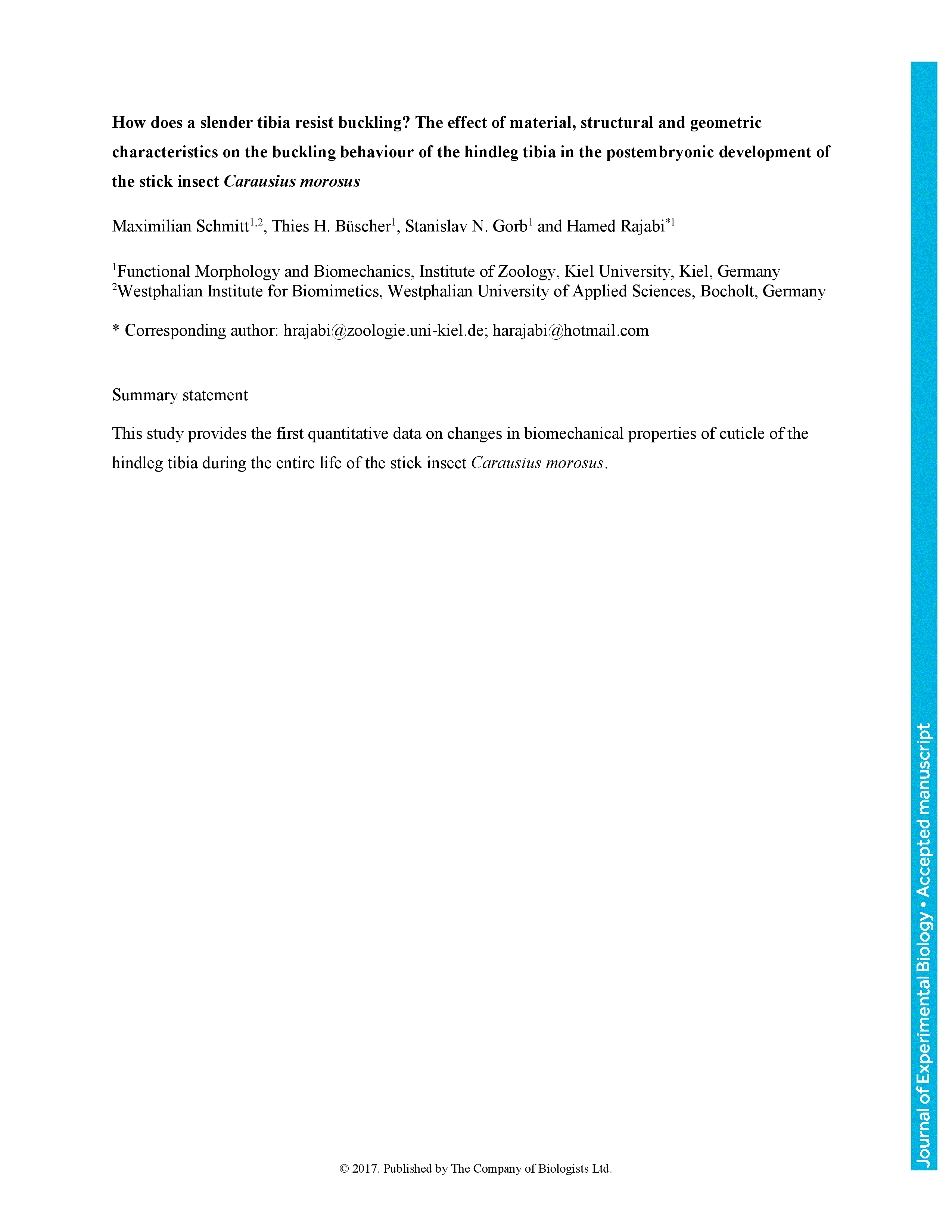During their lifespan, the long and narrow tibiae of the stick insect Carausius morosus (Sinéty, 1901) experience substantial compressive loads. The mechanical load on the tibiae increases as the weight of the insect rises. The increase in the body weight is accompanied by a notable increase in the insect's body size and, accordingly, by an increase in the length of the tibiae. These changes can both raise the risk of buckling of the tibiae. In this study, we track changes in the material and geometric properties of the hindleg tibia of C. morosus during growth. The results show that although buckling (either by Euler buckling or local buckling) is the dominant failure mode under compression, the tibia is well capable of maintaining its buckling resistance in each postembryonic developmental stage. This is found to be essentially the result of a compromise between the increasing slenderness of the tibia and its increasing material stiffness. The use of an optimal radius to thickness ratio, a soft resilin-dominated core, and chitin fibres oriented in both longitudinal and circumferential directions are presumably additional strategies preventing buckling of the tibia. This study, providing the first quantitative data on changes in the biomechanical properties of cuticle during the entire life of an insect, is expected to shed more light on the structure-property-function relationship in this complex biological composite.
How does a slender tibia resist buckling? The effect of material, structural and geometric characteristics on the buckling behaviour of the hindleg tibia in the postembryonic development of the stick insect Carausius morosus
Currently Viewing Accepted Manuscript - Newer Version Available
Maximilian Schmitt, Thies H. Büscher, Stanislav N. Gorb, Hamed Rajabi; How does a slender tibia resist buckling? The effect of material, structural and geometric characteristics on the buckling behaviour of the hindleg tibia in the postembryonic development of the stick insect Carausius morosus. J Exp Biol 2017; jeb.173047. doi: https://doi.org/10.1242/jeb.173047
Download citation file:
Advertisement
2023 JEB Outstanding Paper Prize shortlist and winner

The JEB Editors are delighted to announce the shortlisted authors for the 2023 JEB Outstanding Paper Prize. Read the winning paper - Tiny spies: mosquito antennae are sensitive sensors for eavesdropping on frog calls - by Hoover Pantoja-Sanchez and Brian Leavell from Ximena Bernal's lab at Purdue University, USA.
JEB Science Communication Workshop for ECRs

If you’re an early-career researcher interested in science communication and are attending the SEB Annual Conference in Prague this summer, come a day early and join the JEB Editors at a sci comm workshop to learn the key writing skills needed to promote your research to a broad audience beyond your peers (1 July at 14.30-17.30). Places are limited to 24 attendees, and applicants should apply through the SEB registration page by 30 April 2024.
Bridging the gap between controlled conditions and natural habitats in understanding behaviour

Novel technologies enable behavioural experiments with non-model species, in naturalistic habitats and with underexplored behaviours. In their Commentary, Scholz and colleagues discuss how to obtain a deeper understanding of the natural ecology and lifestyle of study animals.
Beluga metabolic measures could help save species

To help save animals from extinction, it’s important to understand what each species needs to survive. This led Jason John et al. to measure the metabolic rates of captive belugas to develop a ‘fish calculator’ showing that the whales need to eat ~23 salmon per day.
ECR Workshop on Positive Peer Review

Are you an ECR looking for tips on how to write concise, astute and useful manuscript reviews? If so, join the JEB Editors at a 2-hour JEB-sponsored Workshop on Positive Peer Review at the Canadian Society of Zoologists annual meeting in Moncton on 9 May 2024 at 13.00-15.00. There are 25 spaces for ECRs and selection is first come, first serve. To sign up, check the ECR Workshop box when you register for the CSZ meeting.



